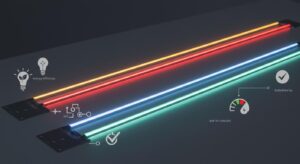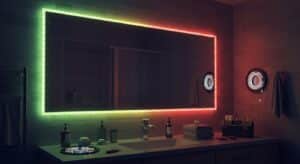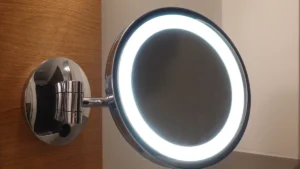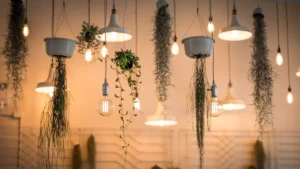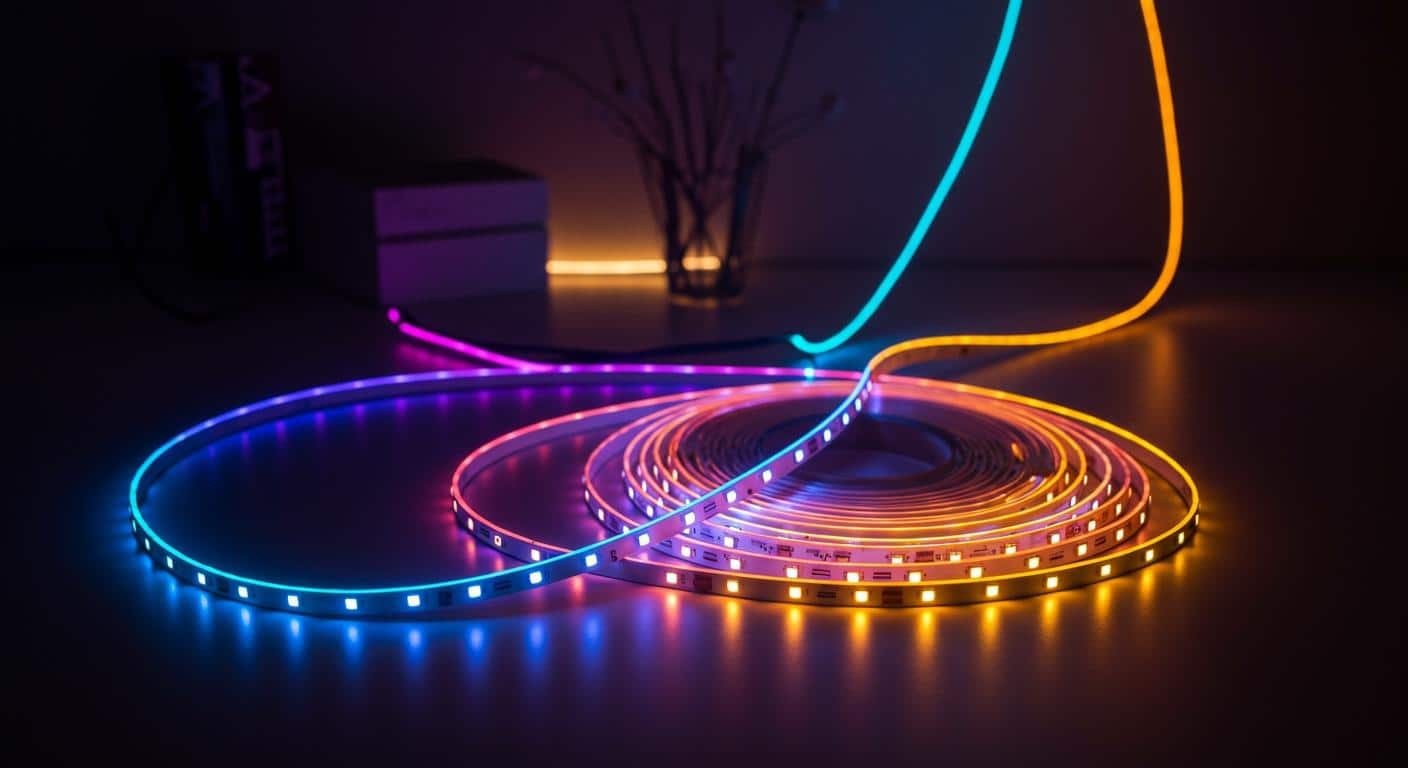
Flexible LED strips are very popular in today’s lighting. These new products have special features that set them apart from regular lights. You can use them in many ways, like home decor or in shops. The worldwide market for flexible LED strips is expected to grow a lot. This growth is because people want energy-saving lights that look good.
Key Takeaways
Flexible LED strips are very adaptable. You can cut them to fit different lengths. This makes them ideal for special spaces.
These strips use less energy. They can save up to 80% more energy than regular bulbs. This helps lower energy bills and reduces carbon footprints.
Installing them is easy and safe because they use low voltage. You can set them up without needing a lot of electrical knowledge.
Flexibility of LED Strip Lights
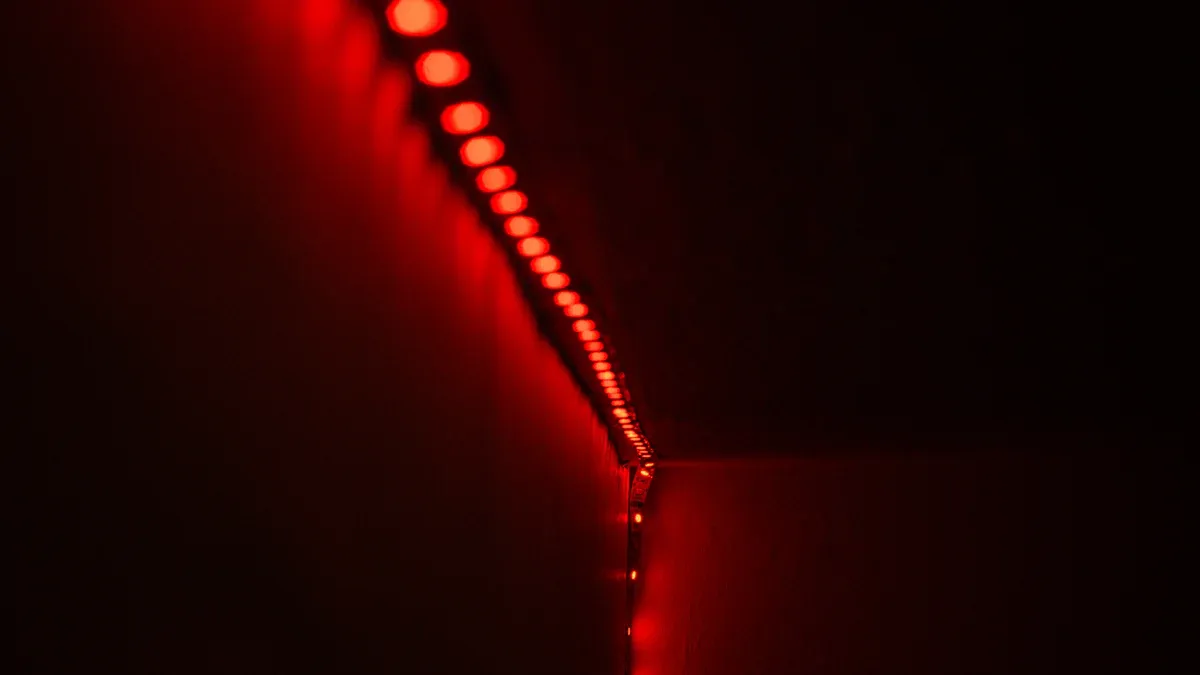
Flexible LED strips are very flexible. This makes them great for many uses. The flexibility depends on the materials used to make them.
LED Strip Substrate
The LED strip substrate is important for how flexible the strips are. Common materials include:
Material Type | Flexibility | Thermal Conductivity | Common Use Case |
|---|---|---|---|
Flexible PCB | High | Moderate | General LED strips |
Aluminum-based | Moderate | High | High-brightness LED strips |
Copper-based | Low | Very High | High-power LED strips |
Silicon-based | Low | Moderate | Specialized applications |
Flexible PCBs (made from polyimide or polyester) can bend easily, which helps with flexibility.
Aluminum substrates manage heat well, which is important for performance but are not very flexible.
Copper substrates conduct heat excellently but are not used much because they are costly and not very flexible.
Silicon substrates have decent properties but are not very flexible, used for special needs.
The strength of polyimide, often used in flexible LED strips, lets them bend without losing performance. This is important for uses that need flexibility, like under-cabinet lighting or detailed designs.
Custom Lengths
Another big benefit of flexible LED strips is that you can get them in custom lengths. This makes them more adaptable, so you can fit them to different spaces.
Feature | Custom Length Options | Standard LED Strips |
|---|---|---|
Adaptability | High | Moderate |
Tailored Installations | Yes | No |
Fit for Unique Layouts | Yes | Limited |
You can cut flexible LED strips at special cut lines, which makes changing their length easy. Each cut part can still connect because of copper solder pads. Users like this flexibility because it allows for quick and cheap installations.
Installation Ease of Flexible LED Strips
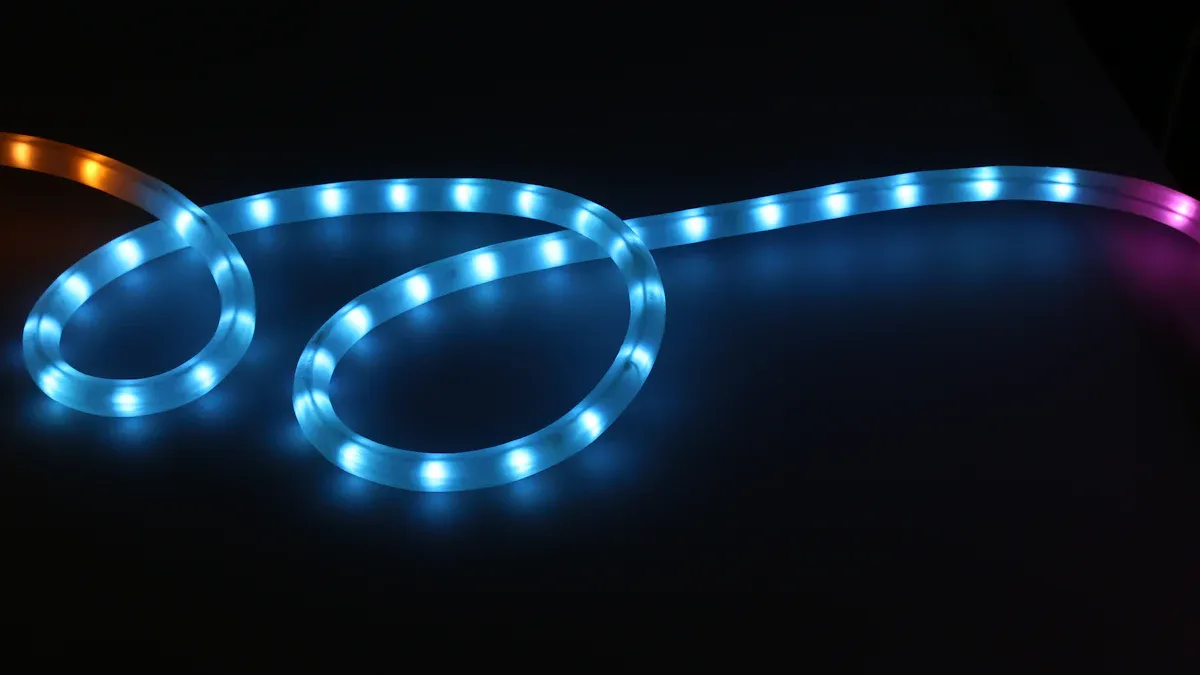
Flexible LED strips are very simple to install. This makes them a favourite for DIY fans and experts. They use low voltage, which makes them safer. You can work with them without needing a lot of electrical knowledge.
Low-Voltage Operation
Using low-voltage LED strip lights has many benefits:
Following home electrical rules keeps you safe from shocks.
Pick LED strips that have safety marks from groups like FCC, UL, and ETL.
Class 2 circuits, which run at 30V or less, are best for homes. They lower the risks of high voltage.
Keeping low voltage and high voltage wires apart lowers safety risks and stops interference.
These features make installation easy. You can set up your lights without any worries.
Waterproof Options
When installing, waterproof options are important for outside or wet areas. Different IP ratings show how much protection they offer:
IP Rating | Description | Protection Level |
|---|---|---|
IP20 | Not waterproof | Stops objects bigger than 12mm, little water and dust protection |
IP54 | Splash-proof | Stops objects bigger than 1mm and vertical water drops |
IP65 | Waterproof against splashes and short immersion | Totally dustproof, protects against low-pressure water spray |
IP67 | Water immersion | Fully dustproof, can be in water up to 1 metre for 30 minutes |
IP68 | Deep waterproof immersion | Completely dustproof, works normally at depths over 1 metre for long times |
Choosing the right waterproof rating keeps your installation safe and working well in different conditions.
You can attach flexible LED strips in many ways. Each method changes how long it takes to install and how easy it is. Here are some common choices:
Mounting Option | Pros | Cons |
|---|---|---|
Adhesive Mounting | Quick to install | May harm the wall when taken off |
No tools needed | ||
Saves time | ||
Clip Mounting | Keeps the strips secure | Needs drilling |
Great for outdoor use | Takes longer to install | |
Channel Mounting | Protects LED strips from dirt | Can be costly |
Gives a smooth lighting look | Takes longer to install |
These mounting choices make for an easy and secure installation, ensuring your flexible LED strips fit well in your chosen space.
Colour Options and Customisation
When you pick flexible LED strips, you can choose from many colours. Some popular options are:
Warm White
Neutral White
Cool White
Red
Green
Blue
Yellow
Pink
Ultra Violet (UV)
RGB (colour-changing)
RGBW (includes white)
These choices help you create the right mood for any room. The RGB colour changing feature lets you change the lights easily. You can mix many colours and use different modes. This flexibility works well for homes and businesses.
You can also use simple control systems with RGB strips. They work on a 3-channel setup, which makes them affordable and easy to set up. These strips are great for party lighting, events, and home decor.
How to Choose a Good LED Strip
When picking a good LED strip, think about these things:
Criteria | Description |
|---|---|
Precision Manufacturing | Strong solder joints make them last longer. |
Durability & Thermal Management | Copper substrates with pure adhesive improve their lifespan. |
Manufacturer Credentials | Choose brands that have experience and safety marks. |
Spectral Quality | Full-spectrum LED chips give true colour reproduction. |
Energy Efficiency | Find strips that give high lumens per watt for the best performance. |
Control Systems
You can control colour and brightness with different systems. Here’s how:
Pick a Control Method: You can use standalone LED controllers, microcontrollers (like Arduino or Raspberry Pi), or software on a computer.
Standalone LED Controllers: These easy-to-use devices have built-in effects.
Microcontrollers: They let you create your own effects.
Software Solutions: These give a simple way to manage effects without needing to code.
Controlling an addressable LED strip helps you make special lighting effects. You can change colour, brightness, and patterns to create spaces that match your feelings or improve your decor.
Energy Efficiency and Performance
Flexible LED strips are known for being energy efficient and performing well. These strips use much less power than regular lights. In fact, LED strip lights can save up to 80% more energy than incandescent bulbs. This big drop in energy use shows how efficient LED technology is.
A normal 60-watt incandescent bulb uses 60 watts each hour.
An equivalent LED strip light only uses about 9-12 watts each hour.
Over 10 hours, the LED strip uses just 90-120 watt-hours.
This efficiency leads to lower energy bills and a smaller carbon footprint. This makes flexible LED strips a good choice for the environment.
Longevity of LED Strip Lights
When you buy flexible LED strips, you can expect them to last a long time. Most good quality LED strip lights last between 25,000 and 50,000 hours. This means about 10 to 15 years of use if you run them for 4 to 6 hours each day. Some top models can even last over 60,000 hours in the best conditions.
The average lifespan of LED strips is about 50,000 hours.
If used for 10 hours daily, they can last more than 13 years.
After this time, they might still work but will be dimmer.
This long life means fewer replacements and lower maintenance costs, making them cost-effective.
Application Scenarios
Flexible LED strips work well in many situations, especially in busy places. Their ability to adapt allows them to fit into tricky designs, like curved walls and staircases. This flexibility makes them look great in places like fancy hotels and restaurants.
In cars, flexible LED strips are useful because they can fit into small spaces and odd shapes. You can use them for both inside and outside lighting, giving vehicles a modern look.
However, you should think about how LED strip lights get rid of heat. Too much heat can hurt performance, causing less light and efficiency, which is called thermal droop. High temperatures can shorten the life of LEDs because their parts wear out faster when they get hot.
To keep them working well, think about these heat management methods:
Thermal Conductive Substrate: Uses materials that transfer heat away from LED chips.
Heat Sinks: Passive devices that help cool by increasing surface area for heat transfer.
Air Circulation: Helps heat escape by letting air flow around the LED strip.
By managing heat properly, you can improve the performance and lifespan of your flexible LED strips.
Flexible LED strips have many benefits compared to regular lights. They save energy, last a long time, and can bend easily. These strips produce less heat, which makes them safer and lowers fire risks. Their light weight makes it simple to install them in different shapes.
Think about using flexible LED strips for your next lighting project. They offer many chances for creativity and efficiency.
Key Benefits of Flexible LED Strips:
Energy Efficiency
Durability
Flexibility
Safety
Minimal Maintenance
Customisation
FAQ
What are flexible LED strips made of?
Flexible LED strips are usually made of a bendable base, LED chips, and sticky backing for easy setup.
Can I cut flexible LED strips?
Yes, you can cut flexible LED strips at special cut lines without harming how they work.
How do I power flexible LED strips?
You can power flexible LED strips with a low-voltage power supply, usually between 12V and 24V, to keep things safe during setup.
